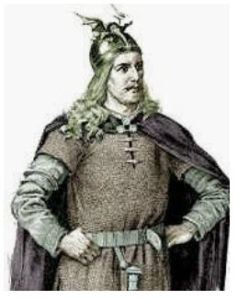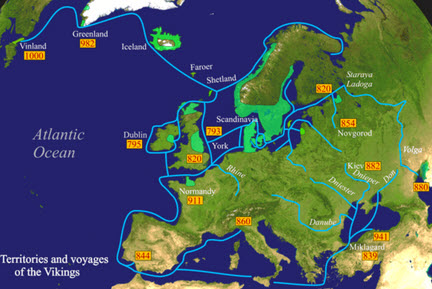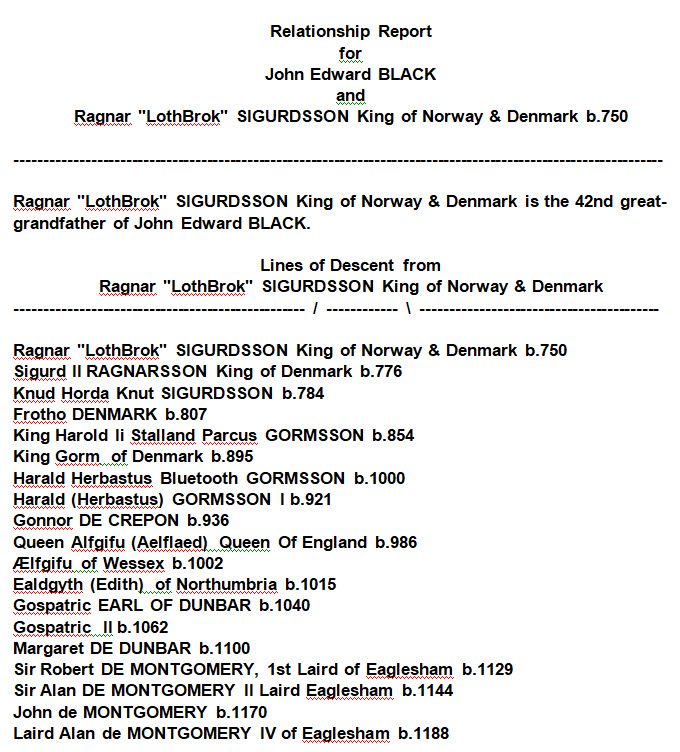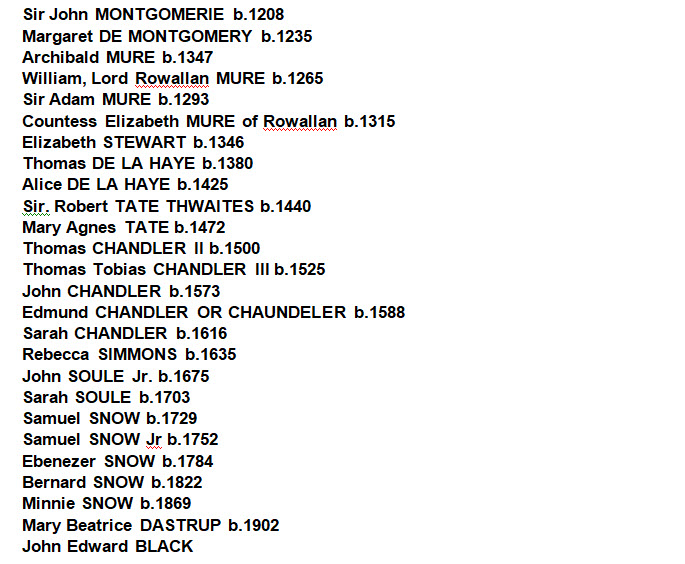Ragnar Lodbrok Sigurdsson b 767, King of Denmark & Sweden
Ragnar Lodbrok Sigurdsson was a Norse Viking hero and legendary king of Denmark and Sweden and is well known from Viking Age Old Norse poetry and sagas. Ragnar lived during the early early days of the Viking age.
The next three ancestral tales will cover your ancestors who were kings over the first unified countries of Norway, Denmark, and Sweden. Consequently, I think it important to provide you with an overview of what it was like in Scandinavia during those early days prior to introducing Ragnar Lodbrok Sigurdsson.
It is important to note that most of what we know about Vikings comes from sagas that were written a couple centuries after the actual event. .Sagas are stories mostly about ancient Nordic and Germanic history, early Viking voyages, the battles that took place during the voyages, and migration to Iceland and of feuds between Icelandic families. They were written in the Old Norse language, mainly in Iceland. Many other experiences were recorded in the form of songs and poetry.
History of Scandinavia
The history of Scandinavia is the history of a geographical region of Scandinavia 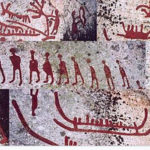 and its peoples. The region is in northern Europe, and consists of Denmark, Norway, and Sweden.
and its peoples. The region is in northern Europe, and consists of Denmark, Norway, and Sweden.
In Scandinavia, the time following the last ice age period begins at circa 9500 BC. With the ice age over, humans began colonizing this new land. However, in recent years there have been archaeological finds in caves which strongly suggest human inhabitation before the Weichsel glaciations, at least 50,000 years ago, presumably by Neanderthals.
Viking Age
Vikings, also called Norseman or Northman, were members of the Scandinavian seafaring warriors who raided and colonized wide areas of Europe. These pagan Danish, Norwegian, and Swedish warriors were probably prompted to undertake their raids by a combination of factors ranging from overpopulation at home to the relative helplessness of victims abroad. The period from the earliest recorded raids in the 790s until the Norman Conquest of England in 1066 is commonly known as the Viking Age of Scandinavian history.
In the western seas, Scandinavian expansion touched practically every possible point. Settlers poured into Iceland from at least about 900, and, from Iceland, colonies were founded in Greenland and attempted in North America. The same period saw settlements arise in the Orkney, Faroe, and Shetland islands, the Hebrides, and the Isle of Man.
How Vikings Governed
The Vikings were ruled by powerful kings and noblemen. The term king was not used in the same way as it is today, because in the Viking period several kings could exist at the same time and they are typically referred to as “petty kings.”In addition, the status of king was not automatically inherited, but had to be fought for.
Below the kings were the nobles or wealthy Vikings known as jarls. They were rich landowners or traders and they employed men to work for them.
Then there were the karls. They were the everyday people and did jobs like farming and craft work. Karls weren’t as rich or important as the jarls, but they weren’t poor either.
At the bottom were the thralls or slaves. They did the hardest, dirtiest jobs and if they tried to run away they could be killed. However, if thralls could earn enough money they could buy their freedom.
The Norse people had their own laws and government. The community would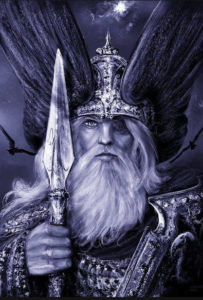 gather together at a meeting called a “Thing.” Here they would settle problems and make decisions. People could vote on what should happen. For example, the Thing might decide who owned a piece of land or how to punish a criminal. All this was overseen by a chieftain or a judge known as a law-speaker. One of the most common methods of punishment was to turn the criminal loose in the forest and let the public go after them and inflict punishment as they saw fit.
gather together at a meeting called a “Thing.” Here they would settle problems and make decisions. People could vote on what should happen. For example, the Thing might decide who owned a piece of land or how to punish a criminal. All this was overseen by a chieftain or a judge known as a law-speaker. One of the most common methods of punishment was to turn the criminal loose in the forest and let the public go after them and inflict punishment as they saw fit.
Viking laws were not written down, so laws were passed from person to person by word of mouth. People who broke the law became outlaws. They were forced to live in the wilderness and anyone was allowed to hunt them down and kill them.
Everyday life
Many Vikings worked as farmers. Everything was to be done by hand. Farmers grew oats, barley and wheat. They ground the grain to make flour, porridge and ale. They planted vegetables too, and kept animals like cows, sheep, pigs and chickens.
Other Vikings were craft workers. They made the things that people needed. Woodworkers and leatherworkers made plates, cups, belts and shoes. Jewellers made rings and brooches from precious metals. Blacksmiths hammered and twisted red-hot iron into tools, knives and swords. Potters baked clay pots in an oven heated by wood fires.
People took these goods to market to sell. Here a family could buy anything from amber beads and apples, to walrus tusks and wolf-skins. Viking traders sold their goods even further away. They sailed the seas to buy silver, silk, spices and furs to bring back home.
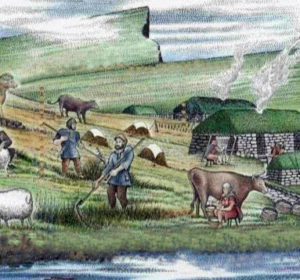 The Viking diet consisted of meat products of all kinds, such as cured, smoked and whey-preserved meat, sausages, and boiled or fried fresh meat cuts were prepared and consumed. There was plenty of seafood, bread, porridges, dairy products, and vegetables. Vikings collected and ate fruits, berries and nuts. Apple wild plums and cherries were part of the diet, as were raspberry, wild strawberry, blackberry, elderberry. Certain livestock were typical and unique to the Vikings, including the Icelandic horse, Icelandic cattle, and a plethora of sheep breeds. The York Vikings mostly ate beef, mutton, and pork with small amounts of horse meat. Chickens were kept for both their meat and eggs. In some places seafood was more important than meat. Whales and walrus were hunted for food in Norway and the north-western parts of the North Atlantic region, and seals were hunted nearly everywhere. Oysters, mussels and shrimps were eaten in large quantities, and cod and salmon were also popular..
The Viking diet consisted of meat products of all kinds, such as cured, smoked and whey-preserved meat, sausages, and boiled or fried fresh meat cuts were prepared and consumed. There was plenty of seafood, bread, porridges, dairy products, and vegetables. Vikings collected and ate fruits, berries and nuts. Apple wild plums and cherries were part of the diet, as were raspberry, wild strawberry, blackberry, elderberry. Certain livestock were typical and unique to the Vikings, including the Icelandic horse, Icelandic cattle, and a plethora of sheep breeds. The York Vikings mostly ate beef, mutton, and pork with small amounts of horse meat. Chickens were kept for both their meat and eggs. In some places seafood was more important than meat. Whales and walrus were hunted for food in Norway and the north-western parts of the North Atlantic region, and seals were hunted nearly everywhere. Oysters, mussels and shrimps were eaten in large quantities, and cod and salmon were also popular..
Milk and buttermilk were popular, both as cooking and drinks, but were not always available. Milk from cows, goats and sheep was used.
Vikings loved silk and spices which required they travel to Russia. Russians had imported them from China.
Many Viking families lived together in a longhouse. They was built from wood or stone and had a thatched or turf roof. With just one room for all the family to share with their animals, a longhouse would have been a crowded and smelly place to live. There was no bathroom inside, but the Vikings kept clean by washing in a wooden bucket or beside a stream. Instead of toilets, people used a cesspit, which was a hole outside dug for toilet waste.
Another important role played by the women of the house was handing on knowledge to the next generation in the home by sharing poems and stories, including the famous myths and sagas that were later written down in medieval Iceland.
Women’s Rights
Women in Viking Age Scandinavia did enjoy an unusual degree of freedom for 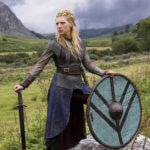 their day. They could own property, request a divorce and reclaim their dowries if their marriages ended. Women tended to marry between the ages of 12 and 15. Though the man was the “ruler” of the house, the woman played an active role in managing her husband, as well as the household. Norse women had full authority in the domestic sphere, especially when their husbands were absent. If the man of the household died, his wife would adopt his role on a permanent basis, singlehandedly running the family farm or trading business. Many women in Viking Age Scandinavia were buried with rings of keys, which symbolized their roles and power as household managers.Although they were few, women rose to a particularly high status and it is said that “Shieldmaidens” dressed like men and fought alongside them.
their day. They could own property, request a divorce and reclaim their dowries if their marriages ended. Women tended to marry between the ages of 12 and 15. Though the man was the “ruler” of the house, the woman played an active role in managing her husband, as well as the household. Norse women had full authority in the domestic sphere, especially when their husbands were absent. If the man of the household died, his wife would adopt his role on a permanent basis, singlehandedly running the family farm or trading business. Many women in Viking Age Scandinavia were buried with rings of keys, which symbolized their roles and power as household managers.Although they were few, women rose to a particularly high status and it is said that “Shieldmaidens” dressed like men and fought alongside them.
Pagan Religion
Vikings followed the traditional religious rituals practiced by Norse pagans in 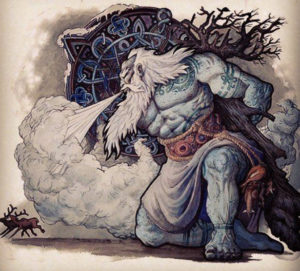 Scandinavia in pre-Christian times. Norse religion was a folk religion, as opposed to an organized religion, and its main purpose was the survival and regeneration of society. Therefore, the faith was decentralized and tied to the village and the family, although evidence exists of great national religious festivals. Norse religion was at no time homogeneous but was a conglomerate of related customs and beliefs. These religious beliefs were heavily connected to Norse mythology. Vikings placed heavy emphasis on battle, honor and focused on the idea of Valhalla, a mythical home with the gods for fallen warriors.
Scandinavia in pre-Christian times. Norse religion was a folk religion, as opposed to an organized religion, and its main purpose was the survival and regeneration of society. Therefore, the faith was decentralized and tied to the village and the family, although evidence exists of great national religious festivals. Norse religion was at no time homogeneous but was a conglomerate of related customs and beliefs. These religious beliefs were heavily connected to Norse mythology. Vikings placed heavy emphasis on battle, honor and focused on the idea of Valhalla, a mythical home with the gods for fallen warriors.
Christianization
Christianity in Scandinavia came later than most parts of Europe. In Denmark Harald Bluetooth Christianized the country around 980 AD+. The process of Christianization began in Norway during the reigns of Olaf Tryggvason (reigned 995 AD–c.1000 AD) and Olaf II Haraldsson (reigned 1015 AD–1030 AD). Olaf and Olaf II had been baptized voluntarily outside of Norway. Olaf II managed to bring English clergy to his country. Norway’s conversion from the Norse religion to Christianity was mostly the result of English missionaries. As a result of the adoption of Christianity by the monarchy and eventually the entirety of the country, traditional shamanistic practices were marginalized and eventually persecuted. Völvas, practitioners of seid, a Scandinavian pre-Christian tradition, were executed or exiled under newly Christianized governments in the eleventh and twelfth centuries
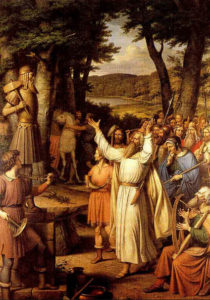 Sweden required a little more time to transition to Christianity, with indigenous religious practices commonly held in localized communities well until the end of the eleventh century. A brief Swedish civil war ensued in 1066 primarily reflecting the divisions between practitioners of indigenous religions and advocates of Christianity; by the mid-twelfth century, the Christian faction appeared to have triumphed; the once resistant center of Uppsala became the seat of the Swedish Archbishop in 1164. The Christianization of Scandinavia occurred nearly simultaneously with the end of the Viking era. The adoption of Christianity is believed to have aided in the absorption of Viking communities into the greater religious and cultural framework of the European continent.
Sweden required a little more time to transition to Christianity, with indigenous religious practices commonly held in localized communities well until the end of the eleventh century. A brief Swedish civil war ensued in 1066 primarily reflecting the divisions between practitioners of indigenous religions and advocates of Christianity; by the mid-twelfth century, the Christian faction appeared to have triumphed; the once resistant center of Uppsala became the seat of the Swedish Archbishop in 1164. The Christianization of Scandinavia occurred nearly simultaneously with the end of the Viking era. The adoption of Christianity is believed to have aided in the absorption of Viking communities into the greater religious and cultural framework of the European continent.
RAGNAR LODBROK SIGURDSSON b 767
Ragnar Loldbrok Sigurdsson is my 42nd Great Grandfather. What is known about him comes mostly from sagas, songs, and poetry. I have chosen to begin with him because of the general interest our present society has in the Viking age. Please be aware that the accounts of his life and adventures were written two centuries after his death .Consequently, there are varying accounts.
Ragnar Lodbrok SIGURDSSON, Legendary King of Denmark and Sweden, was born about 767 in Uppsala, Uppsala, Sweden. He died in 845 in Northumbria, England. He was buried in 845 in Uppsala, Uppsala, Sweden. Ragnar married Aslaug Sigurdsdottir WOLSUNG in 783 in Århus, Denmark. Aslaug was born about 755 in Ringerike, Buskerud, Norway. She died in 870 in Ringerike, Buskerud, Norway.
Ragbar’s father was Sigurd “Ring” RANDVARSSON King of Sweden who was born in 730 in Uppsala, Uppsala, Sweden. He died in 812 in Bråvalla, Östergötland, Sweden and was buried in Roskilde, Roskilde, Denmark. Sigurd married Alfhild GANDOLFSDOTTIR Queen of Denmark & Norway.
Ragnar Lothbrok was a historically Norse Viking hero and legendary king of Denmark and Sweden, known from Viking Age Old Norse poetry and sagas. According to that traditional literature, Ragnar distinguished himself by many raids against Francia and Anglo-Saxon England during the 9th century.
Legendary Wives of Ragnar Lothbrok :
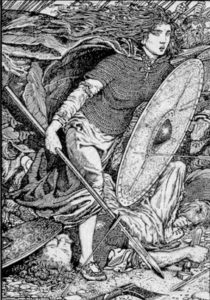 Ladgerda, who, though a maiden, had the courage of a man, and fought in front among the bravest with her hair loose over her shoulders. All marvelled at her matchless deeds, for her locks flying down her back betrayed that she was a woman.
Ladgerda, who, though a maiden, had the courage of a man, and fought in front among the bravest with her hair loose over her shoulders. All marvelled at her matchless deeds, for her locks flying down her back betrayed that she was a woman.
Impressed with her courage, Ragnar courted her from afar. Lagertha feigned interest and Ragnar arrived to seek her hand, bidding his companions wait in the Gaular valley. He was set upon by a bear and a great hound which Lagertha had guarding her home, but killed the bear with his spear and choked the hound to death. Thus he won the hand of Lagertha. According to Saxo, Ragnar had a son with her, Fridleif, as well as two daughters, whose names are not recorded
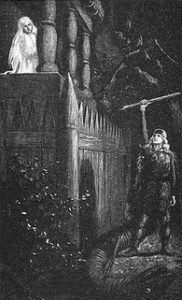 Thora Borgarhjört , is a mythical character in the Norse sagas – the wife of Ragnar Loðbrók, who kills a serpent to win her hand in marriage.
Thora Borgarhjört , is a mythical character in the Norse sagas – the wife of Ragnar Loðbrók, who kills a serpent to win her hand in marriage.
According to the sagas, Thora lived in a bower in Västergötland. Her father gave her a small lindworm that grew into a large serpent and encircled the bower. Her father promised Thora’s hand in marriage to any man who could slay the serpent.
After divorcing his first wife, the shield-maiden Lagertha, Ragnar wanted to make Thora his wife. He went to the bower, wearing breeches that he had treated with tar and sand to protect his legs from the serpent’s poison. It was from these that he gained the epithet Loðbrók (which literally means “Hairy-Britches”). Wielding a spear, Ragnar approached the serpent. It spat poison at him, but the poison could not penetrate Ragnar’s shield or breeches. He stuck his spear through the serpent’s heart and cut off its head. Thora and Ragnar were then married.
According to the Tale of Ragnar’s Sons (Ragnarssona þáttr), Thora and Ragnar had two sons, Eiríkr and Agnar
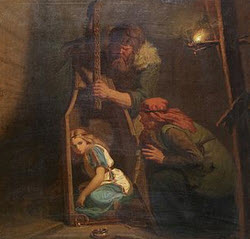 Aslaug, according to the 13th-century Tale of Ragnar Lodbrok, Aslaug was the daughter of Sigurd and the shieldmaiden Brynhildr, but was raised by Brynhildr’s foster father Heimer. At the deaths of Sigurd and Brynhildr, Heimer was concerned about Aslaug’s security, so he made a harp large enough to hide the girl. He then traveled as a poor harp player carrying the harp containing the girl.
Aslaug, according to the 13th-century Tale of Ragnar Lodbrok, Aslaug was the daughter of Sigurd and the shieldmaiden Brynhildr, but was raised by Brynhildr’s foster father Heimer. At the deaths of Sigurd and Brynhildr, Heimer was concerned about Aslaug’s security, so he made a harp large enough to hide the girl. He then traveled as a poor harp player carrying the harp containing the girl.
They arrived at Spangereid at Lindesnes in Norway, where they stayed for the night in the house of the peasants Áke and Grima. Áke believed the harp contained valuable items and told his wife Grima. Grima then convinced him to murder Heimer as he was sleeping. However, when they broke the harp open, they discovered a little girl, whom they raised as their own, calling her Kráka (“Crow”). In order to hide her beauty, they rubbed her in tar and dressed her in a long hood.
However, once as she was bathing, she was discovered by some of the men of the legendary king Ragnar Lodbrok. Entranced by Kráka’s beauty, they allowed the bread they were baking to burn; when Ragnar inquired about this mishap, they told him about the girl. Ragnar then sent for her, but in order to test her wits, he commanded her to arrive neither dressed nor undressed, neither fasting nor eating, and neither alone nor in company. Kráka arrived dressed in a net, biting an onion, and with only a dog as a companion. Impressed by her ingenuity and finding her a wise companion, Ragnar proposed marriage to her, which she refused until he had accomplished his mission in Norway. She gave him five sons: Ivar the Boneless; Björn Ironside; Hvitserk; Rognvald; and Sigurd Snake-in-the-Eye.
Sons of Ragnar, an intregal part of history
Ragnar is said to have up to eleven sons. However, the three sons that were an integral part of history (not sagas) were Halfdan, Inwaer (Ivar the Boneless), and Hubba (Ubbe). These three brothers, according to medieval sources, led a army know as the “Great Heathen Army,” in an invasion against the English at East Anglia in 865. It is said that they sought to avenge their fathers death who had been captured executed earlier by King Aella of Northumbria .
The most significant medieval sources that mention Ragnar include:
- Book IX of the Gesta Danorum, a 12th-century work by the Christian Danish chronicler Saxo Grammaticus
- the Tale of Ragnar’s sons (Ragnarssona þáttr), a legendary saga
- the Tale of Ragnar Lodbrok, another saga, a sequel to the Völsunga saga
- the Ragnarsdrápa, a skaldic poem of which only fragments remain, attributed to the 9th-century poet Bragi Boddason
- the Krákumál, Ragnar’s death-song, a 12th-century Scottish skaldic poemthe Reginherus or Ragnar who besieged Paris in the mid-9th century
- possibly the Ragnall (Rognvald) of the Irish Annals[
In popular Culture Ragnar Lodbrok features prominently in:
- History‘s popular 2013 TV series Vikings, Australian actor Travis Fimmel played the lead character of Ragnar Lothbrok for the first four seasons.
- Edwin Atherstone‘s novel Sea-Kings in England
- Edison Marshall‘s 1951 novel The Viking
- The 1958 film The Vikings based on Marshall’s novel, in which Ragnar, played by Ernest Borgnine, is captured by King Ælla and cast into a pit of wolves; a son named Einar [sic], played by Kirk Douglas, vows revenge and conquers Northumbria with help from half-brother (and sworn enemy) Eric (played by Tony Curtis), who also had much to avenge upon King Aella
- Harry Harrison‘s 1993 alternative history novel The Hammer and the Cross depict Ragnar being shipwrecked, captured and executed, as well as his sons’ revenge.
